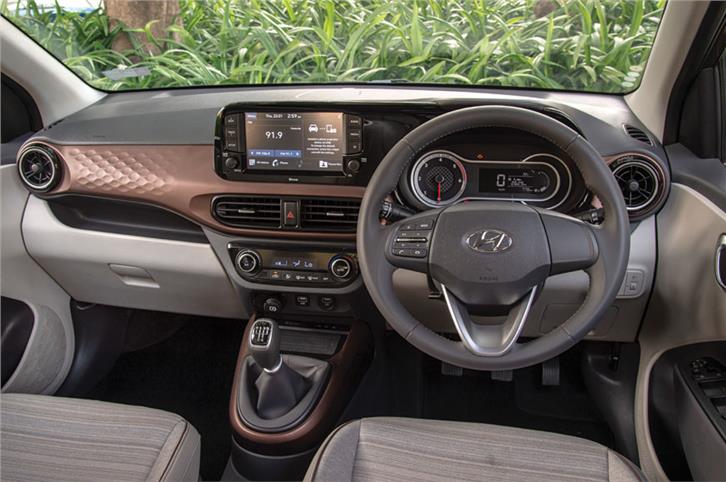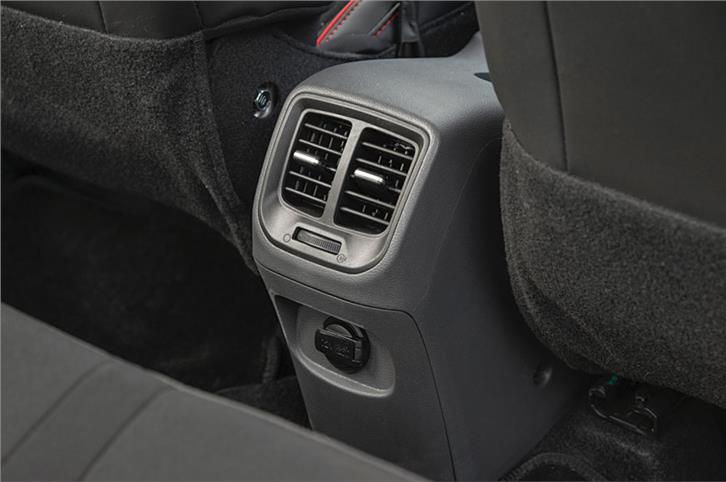Hyundai’s latest compact sedan sure does look promising, but does it have the right ingredients to be the next success story? We find out.
Published on Jan 28, 2020 11:00:00 AM
49,698 Views
Follow us on.jpg&w=726&h=482&q=75&c=1)


When it comes to the number of players in it, the compact sedan segment is anything but compact. And now entering the royal rumble is the Hyundai Aura. With its rival being Maruti Dzire –which accounts for more than 50 percent of the sales in this segment – there’s no doubt that the Hyundai Aura has its work cut out for it to carve some space for its own. What works in the Aura's favour, though, is that buyers have a wide range of powertrains to choose from – all of which are BS6-compliant. There’s an 83hp, 1.2-litre petrol engine from the Nios, and you also have a 69hp, CNG variant of the same. The 75hp, 1.2 diesel engine is also the same as the Nios', but it is in the BS6 avatar for the first time. In addition to this, there’s the 1.0-litre turbo-petrol engine from the Venue compact SUV, but it makes 100hp instead of 120hp.

Just like most of the recent cars from Hyundai, the Aura is loaded with features. So, with the Xcent now selling in the fleet market, could this be the model that could revive Hyundai’s presence in the segment. Let find out.
The Aura’s face is similar to the Grand i10 Nios on which it is based, but there are a few design elements that differentiate the sedan from the hatchback. For starters, the oversized ‘cascading grille’ is smaller on the Aura and gets a satin grey surround trim. In the turbo-petrol variant, it gets a black surround, which looks much better. The wide grille now houses double boomerang LED DRLs at the top. Sweptback halogen projector headlamps and the bonnet with aggressive creases have been carried over from the Nios, and they work well here too.

In terms of dimensions, while the length of all the cars in this segment is just short four metres, the Aura is narrower than the Maruti Suzuki Dzire, Honda Amaze, and even the Ford Aspire. In profile, you can see how Hyundai has stretched the Nios’ length, without making it feel like just a slap-on boot modification. The 2,450mm-long wheelbase is 25mm longer than the Xcent’s, which translates into marginally more cabin space. The roofline merges into the boot nicely and ends in a neat little ducktail spoiler. It's at the rear that the Aura’s design might polarise opinions. While the LED tail-lights look good, they do seem oversized and don’t go well with the overall design language.
The Aura’s cabin is heavily based on the Nios’ cabin, and the only differentiator here is the dashboard trim above the glovebox, which comes in a satin bronze finish. The turbo-petrol variant gets an all-black interior theme with red inserts. The seats, finished in black with red stitching, look great with the honeycomb pattern on them, and also accentuate the sporty feel of the cabin.

The doors of the Aura open wide, thanks to the placement of the seats, ingress and egress is quite easy. On the inside, you get a dual-tone (black and light grey) dashboard with the big 8.0-inch touchscreen taking centre stage. The touchscreen's layout is user-friendly and is quite responsive as well. While there’s no e-SIM for connected car features, you do get Hyundai's iblue system that allows you to control the stereo via your smartphone. Running between the touchscreen and instrument cluster is a piano black trim that makes them look like a single unit. High-quality materials do make the cabin feel premium, and what’s even more important is that the fit and finish levels are impressive too.

The front seats are wide, supportive and comfy, but they don’t get adjustable headrests like on the Dzire. Moreover, the fixed headrests are small, which can be uncomfortable for tall drivers. . Also, the lumbar support is a little excessive and might cause discomfort while driving for long hours. Getting in to the rear, the cabin is just marginally roomier than the Xcent’s, but legroom is down from the Dzire's. However, it doesn’t feel cramped. The long seat squab provides good under-thigh support, and headroom is adequate for tall passengers; passengers taller than 6ft might be left wanting for more room. The backrest is set at a nice and comfortable angle, with adjustable headrests for rear passengers. A fixed headrest for the middle passenger, as seen on the Xcent, is missing. The 402-litre boot is quite spacious, but the loading lip is high.

The Aura line-up has five variants, and like we said earlier, it is loaded with features. The turbo-petrol and AMT variants are offered in the SX+ trim, while the petrol- and diesel-manual variants are offered in the top-end SX(O) trim. While the difference between the two variants is predominantly cosmetic, the SX+ variant misses out on a leather-wrapped steering wheel and gear knob. Talking about the features in these two variants: you have an 8.0-inch touchscreen with Android Auto and Apple CarPlay, a 5.3-inch MID screen, wireless phone charger, cruise control (top-end petrol-manual only), rear AC vents, and a 12V charging socket for rear passengers. In terms of safety, Hyundai has equipped the Aura with dual airbags, ABS with EBD, ISOFIX child seat anchors, emergency stop signal and rear parking sensors with a camera.

We got to drive the new 1.0-litre turbo-petrol engine with a 5-speed manual transmission, and the BS6 diesel engine with the 5-speed manual and AMT gearbox. The 1.0-litre, three-cylinder turbo-petrol engine is quiet at idle, but you can still feel the vibrations on the steering wheel and the pedals. Start driving and you will notice that the motor is quite rev-happy, and moves through the range quite willingly. The turbo kicks in early, just above 1,800rpm, and provides a strong surge of power. However, the best part of the engine is its wide powerband – it makes keeping up with traffic and making quick overtakes easy. Climb up the rev range, though, and the engine gets audible. Beyond 5,000rpm, it gets quite loud. But since power keeps coming in strong until almost 6,000rpm – and the engine has a hint of sporty growl to it – enthusiasts won’t mind being in the higher revs. Accompanied by a light clutch and gearbox combination, the turbo-petrol is an easy car to drive in both, a sedate and an enthusiastic manner.
.jpg&c=0)
In its BS6 guise, the 1.2-litre, three-cylinder diesel engine is quite refined. At idle, you can hear the diesel clatter but that slowly smoothens out as you start driving. Driving at low speeds isn’t much of a problem as the engine is quite responsive, and the strong bottom-end masks turbo lag well. You won’t be shifting through the gears too much while driving through the city. In the mid-range, the engine has good power on tap until 4,000rpm; beyond that, it starts losing steam. On the highways while cruising, the diesel runs silently and you won’t have to downshift too often to overtake. The clutch and gearbox remain effortless to use and smooth in the diesel variant as well. The AMT unit has a smooth creep function, and while the typical head-nod is present, it is better than some of the other AMT units out there. And to keep the jerk between shifts to a minimum, the gearshifts aren’t quick.

The Aura has MacPherson struts up front and a torsion beam axle at the rear, and rides on 175/60 R15 tyres – all of which makes the ride quality quite absorbent. There is an underlying stiffness to the suspension, though, which is why sharp potholes and bumps are felt in the cabin. On the highways, the Aura feels quite stable. A point worth mentioning here is that since the diesel has a heavier front-end, it feels more planted than the petrol variant. Similarly, in the corners, the diesel’s steering's heavier weight makes it much nicer to drive. The steering still doesn’t feel connected, but the added weight allows you to carry more speed into corners. In contrast, the turbo-petrol variant, which is the engine that will be preferred by most enthusiasts, has a lighter steering. The brakes work well in emergency situations and the pedal feel is also progressive, with a nice and strong bite point as soon as step on it.
Designed and specified to stand out from the crowd, and especially take on the Maruti Dzire, the Hyundai Aura comes with flashy styling, it is well equipped and comfortable on the inside, and gets a choice of some capable engines, including a powerful and fun turbo-petrol, and a BS6 diesel. This works well for the Aura as the two major players in the segment, the Dzire and Tigor won't have a diesel option after April 2020. Buyers also get the option of AMT on the 1.2 petrol and diesel engines.
The Hyundai Aura is priced competitively against the Dzire, with prices starting at Rs 5.80 lakh (ex-showroom, Delhi), with the diesel in BS6 form only costing Rs 20,000 more than the one on the Xcent. Yes, the cabin isn’t as spacious as the competition, the turbo-petrol is a bit expensive at Rs 8.55 lakh, and there's no automatic version of the turbo-petrol. Still, the Aura offers so much more compared to the competition in certain areas, it seems poised to take a large slice of the compact sedan pie.
Copyright (c) Autocar India. All rights reserved.

Maruti Suzuki plans to use the Boosterjet engine in more models. Which one would you like to see it in?
Comments
Member Login
Personal Details
No comments yet. Be the first to comment.